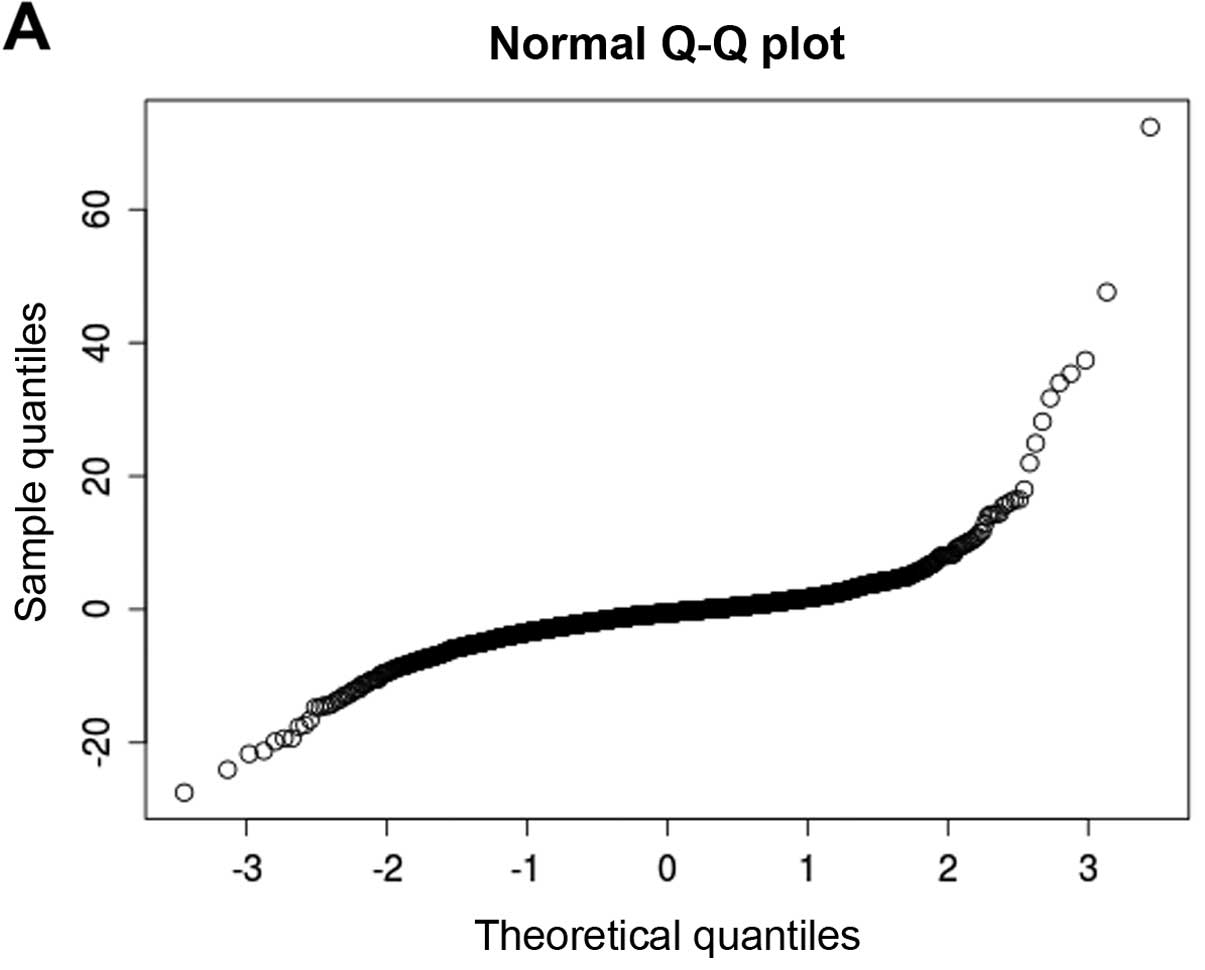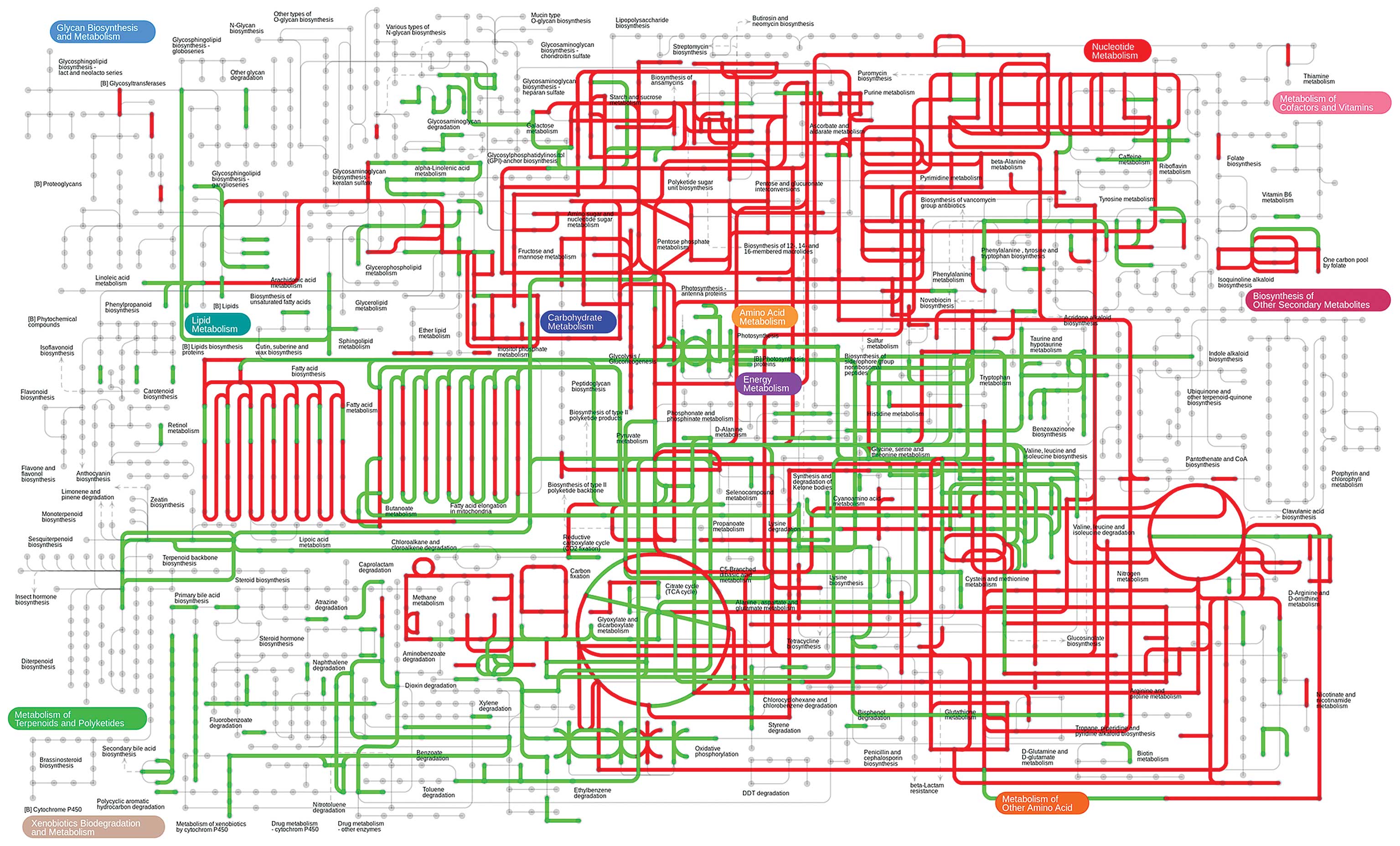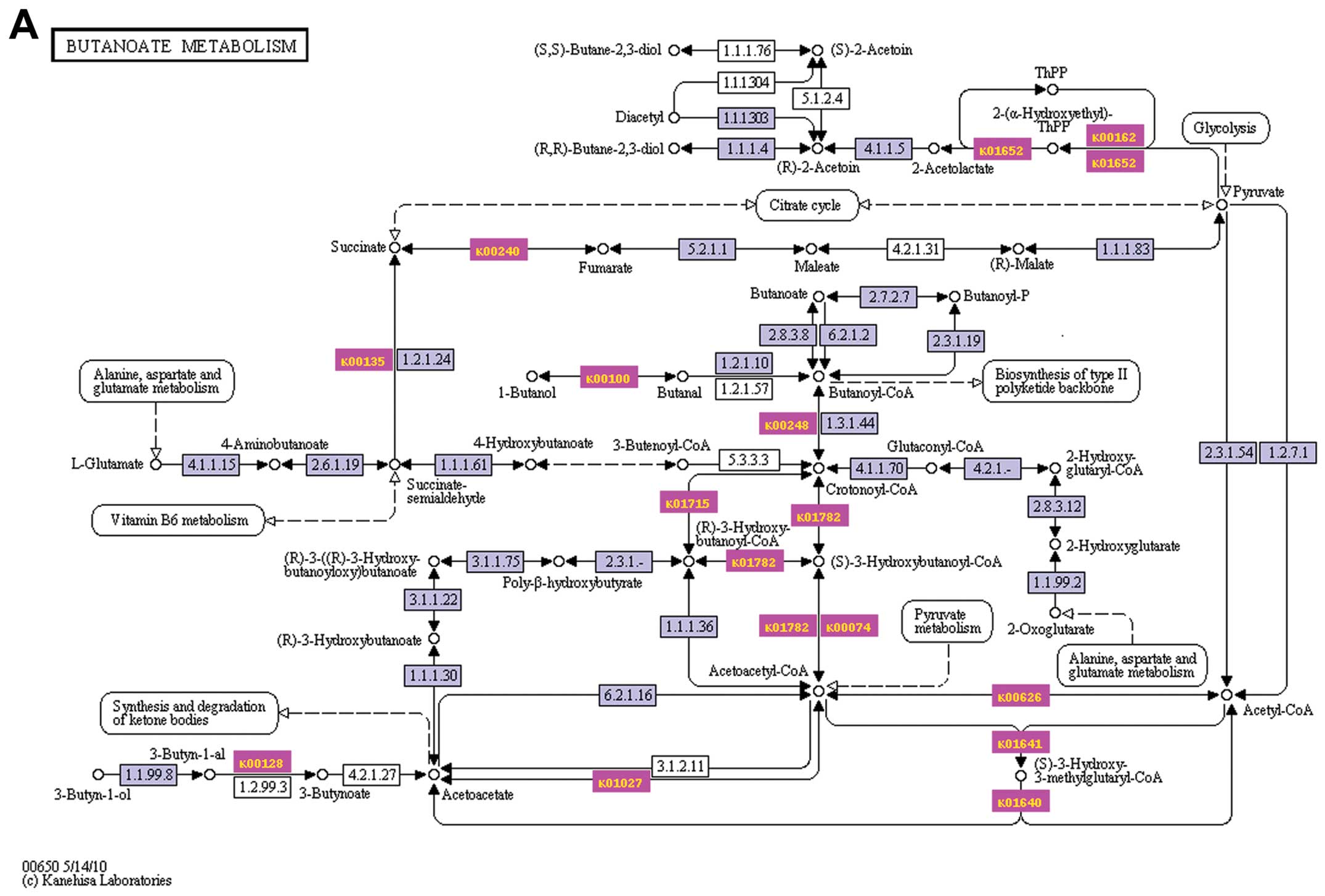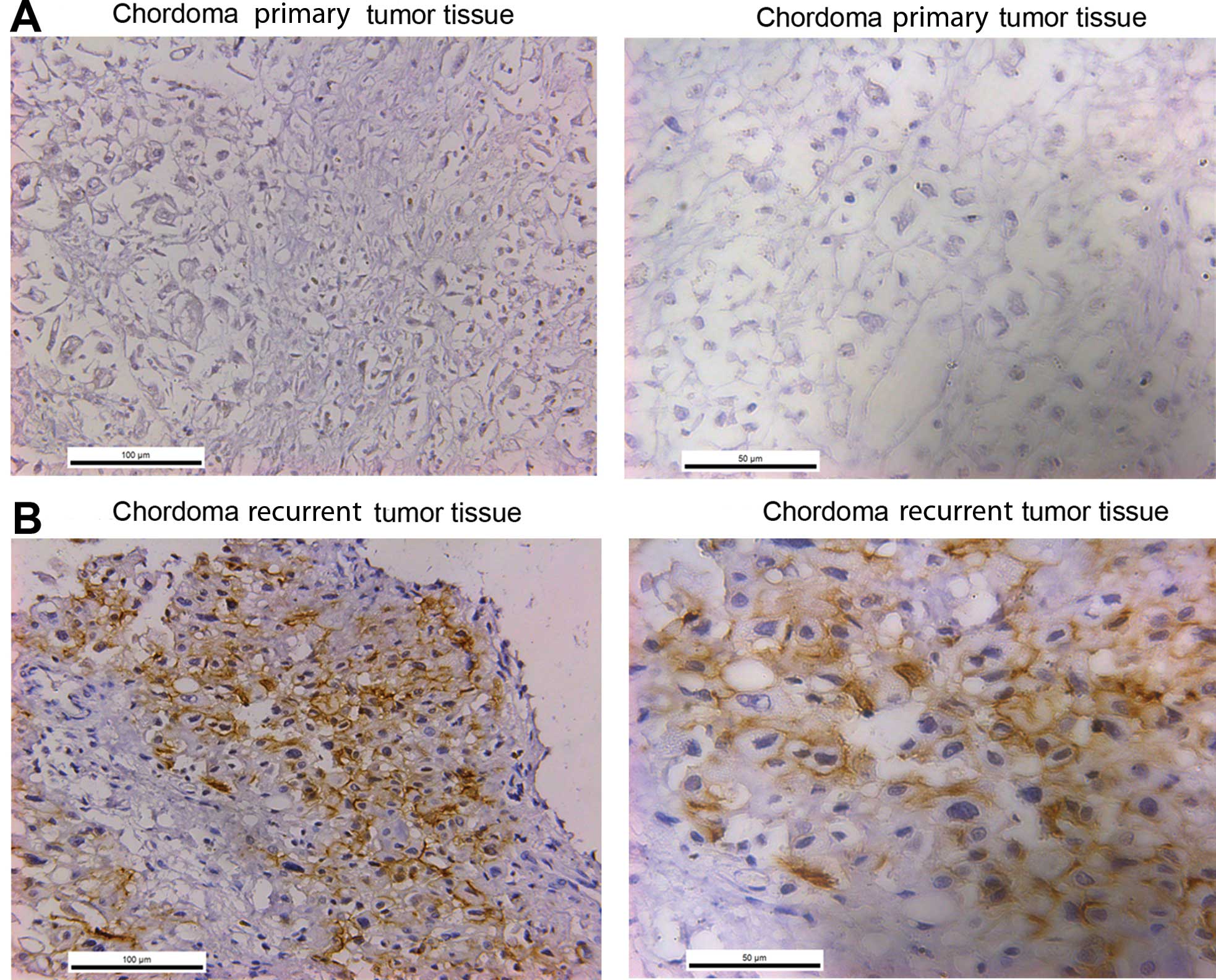Differential proteomic profiling of primary and recurrent chordomas
- Authors:
- Published online on: February 26, 2015 https://doi.org/10.3892/or.2015.3818
- Pages: 2207-2218
Abstract
Introduction
Chordoma is a rare slow-growing neoplasm thought to arise from cellular remnants of the notochord. The incidence of chordoma is approximately 1 case in one million individuals and it accounts for ~1–4% of all tumor cases. However, these rare tumors present very significant treatment challenges (1). It is notable that 67% of the surgically managed patients suffer local recurrence, and the disease-free survival at 5 years is almost 0% (1,2).
Complete surgical resection followed by radiation therapy offers the best chance of long-term control for chordoma. However, incomplete resection of the primary tumor makes controlling the disease more difficult and increases the odds of recurrence. Tumors at certain sites such as skull base chordoma can hardly be removed completely due to the complicated peritumoral tissue structure which makes the tumor difficult to be exposed. Thus, recurrence of skull base chordoma is as high as 85%. Chordomas are relatively radioresistant as well, requiring high doses of radiation to be controlled. The proximity of chordomas to vital neurological structures such as the brain stem and nerves limits the dose of radiation that can safely be delivered. A strategy to control the recurrence of chordomas is vital for improving the survival rate of patients. It is imperative to explore chordoma recurrence mechanisms at the molecular level and to search for alternative therapeutic methods including chemotherapy to treat it. Recently, Zhou et al assessed the chordoma proteome in chordoma tumor tissues and identified ENO1, PKM2, and gp96 proteins as being upregulated in chordomas. They reported that the expression of these proteins was higher in recurrent than that in the primary chordomas (3). However, the molecular mechanisms involved in chordoma recurrence remain unstudied, and the detailed changes in proteomic profiling in the process of recurrence remain unclear.
We analyzed 3,296 proteins identified by mass spectrum in a chordoma patient original tumor (CSO) and recurrent tumor (CSR) tissue. Bioconductor’s Global Anova test was applied to compare the overall proteomic profiling changes between CSO and CSR which indicated there was a significant difference (P≤0.1). Bioconductor’s multtest found that 359 proteins exhibited the highest expression difference between CSO and CSR. KEGG database analysis of the 359 proteins revealed that 21 pathways had a significant change between CSO and CSR. Immunohistochemistry (IHC) further verified that cancer stem cell marker activated leukocyte cell adhesion molecule (ALCAM or CD166) was markedly upregulated in the CSR tissue.
Materials and methods
Tissue specimen processing
Chordoma specimens were obtained from a resected tumor following an institutional review board approved protocol. The histological composition of the samples was assessed by examining adjacent sections. Tumor samples were dissected and only tissue that was superfluous to that required for pathological evaluation was taken. The samples were immediately snap-frozen in liquid nitrogen and stored at −80°C. Approximately 800 μg of tissue samples was cut into small pieces with a scalpel and transferred into a mortar filled with liquid nitrogen. The tissue was ground to a fine powder with a pestle in the continuous presence of liquid nitrogen and transferred into a reaction tube with extraction buffer [2 M thiocarbamide, 7 M urea and 10 μM proteinase inhibitor (Roche Diagnostics, Indianapolis, IN, USA)] at 4°C. The solution was centrifuged at 16,000 × g at 4°C for 15 min, and the supernatant (~300–400 μl) was stored frozen at −200°C.
Proteome analysis
The protein concentration was determined by Amersham 2D quant kit (GE Healthcare Bio-Sciences, Piscataway, NJ, USA). The protein samples were further lysed to peptides and prepared for proteome analysis as described previously (4). Peptides were analyzed using strong cation (SCX)/reversed phase, upgrade performance liquid chromatography (Nano-RPLC)/ESI/MS/MS. Samples were analyzed using a LTq Orbitrap XL (Thermo Electron Corp., Bremen, Germany) mass spectrometer. MS/MS spectra data were searched against the Swiss-Prot Human (2009.02.10, 20331 sequences) database or IPI database using Bioworks Browser 3.3.1 SP1. The identified proteins were quantified by APEX software (5,6). To control the false-positive rate, finally the quantitative results by false-discovery rate (FDR) 1% or less (false-positive rate of 1% or less) as the standard filter.
Immunohistochemistry
The paraffin sections were dried in an oven at 65°C for 1 h. The paraffin sections were then dewaxed in xylene and rehydrated in a series of ethanol solutions. The endogenous peroxidase activity was blocked by a 10-min pre-incubation with 3% H2O2. The paraffin sections were preheated at 100°C in antigen retrieval solution containing EDTA (pH 8.0) for 30 min and blocked by non-immune goat serum at room temperature for 15 min to decrease unspecific staining. Incubation with mouse polyclonal anti-ALCAM (1:1,000 dilution) was performed overnight at 4°C. After being washed 3 times with 1X PBS buffer for 3 min, the sections were incubated with the secondary (link) antibody (biotinylated mouse-anti-human IgG) for 30 min at room temperature. After reacting with the streptavidin-biotin-peroxidase complex for 20 min, the immunoreactivity was determined by 3,3′-diamino-benzidine tetrahydrochloride and H2O2 at room temperature according to the manufacturer’s instructions. The positive reaction was manifested as brown (DAB) staining. The sections were counterstained in Mayer’s hematoxylin. The selected sections were scanned at ×400 magnification to visualize the localization and distribution of ALCAM.
Statistical analysis
Statistically significant proteins were identified by first performing a two-tailed Student’s t-test with the ‘multtest’ package in rat the respective time-points by comparing protein abundance between CSO and CSR. Multiple hypothesis testing was then implemented with the ‘rawp2adjp’ function in R by correcting the P-values according to Benjamini and Hochberg procedures (7) to control the FDRs to ≤1%. Proteins with a FDR ≤1%, peptide count ≥3, and fold-change ≥2 were identified as statistically significant. Throughout the present study, upregulation is defined as higher protein abundance measured in CSR relative to CSO and downregulation refers to fewer proteins measured with CSR. Moreover, a positive expression ratio represents upregulation and negative represents downregulation. Blast2Go (8) was used as a comprehensive bioinformatics tool for the functional annotation of the protein sequences in the present study such as determining gene ontology terms. The metabolic map at CSR was generated by first using the statistically significant proteins to identify the key pathways. Once the pathways were identified, all of the detected proteins in the same pathway were evaluated to determine whether they were upregulated or downregulated relative to the control. If ≥50% of the proteins in the pathway was regulated similarly in the same direction, then the pathway would be designated as upregulated or Downregulated according to the majority. The cellular pathways are displayed using the iPath 2.0 platform (9).
Results and Discussion
In order to obtain a comprehensive proteomic profile of CSO and CSR and to investigate the mechanism of recurrence, the proteome of patient CSO and CSR tumor tissue samples was analyzed with LC/MS. In total, 3,296 unique protein sequences were identified. Bioconductor’s Global Anova package was used to determine the significance of the protein expression change between CSO and CSR. A protein expression difference with P≤0.1±0.002 was defined as statistically significant (Table I). Furthermore, we applied Bioconductor’s multtest package to analyze the identified 3,296 proteins and found that a large number of proteins (359) showed significant changes in expression with BH ≤0.01 and P≤0.01 between CSO and CSR. These proteins were involved in central metabolism, genetic information transcription and other processes essential to cell functions. Of these 359 proteins, there were 244 Downregulated proteins (CSR/CSO value ≤0.1) and 115 upregulated proteins (CSR/CSO ≥9) (Fig. 1; Table III and IV). This analysis discovered many significant proteins which have never been reported before in recurrent chordomas.
Among the top downregulated proteins, podocan is involved in negative regulation of cell migration and proliferation, concomitant with increased p21 expression which is a tumor-suppressor gene and can mediate cellular senescence (10). ZO-1 has been shown to be downregulated in poorly differentiated, highly invasive breast cancer cell lines (11), and downregulation of complement factor I (CFI) is regarded as a potential suppressive protein for gastric cancer identified by serum proteome analysis (12). Downregulation of osteomodulin (OMD) is referred to in the context of uterine serous papillary carcinoma. It was further disclosed that activation of OMD or/and PRELP gene expression or function can suppress cancer initiation and development (13). FK506-binding protein 4 (FKBP4) was reported to have cancer-specific methylation which usually inactivates this gene in breast cancer tissues (14). We are the first to report downregulation of these tumor-suppressing proteins in recurrent chordomas. The markedly decreased expression of these tumor-suppressing proteins suggests that recurrent chordomas are more aggressive than primary chordomas. While the top upregulated proteins included myosin-7 (MYH7) which is related to eukaryotic cell motility; CD166 (ALCAM) has been regarded as a potential cancer stem cell marker (15). Splicing factor, arginine/serine-rich 2 (SFRS2) demonstrated Wnt signaling-dependent activation which promotes cell migration (16); and Ras-related protein Rab-11A (RAB11A) can differentially modulate epidermal growth factor-induced proliferation and motility in immortal breast cells (17). These newly identified upregulated molecules in recurrent chordomas by our analysis may be possible biomarkers for diagnosis and/or targets for treating recurrent chordomas. Our study also provides valuable information for future studies on chordoma recurrence mechanisms which remain unelucidated.
To investigate which signaling pathways have alterations in CSR, we searched the 359 identified proteins with significant change in the KEGG database and found that there were over 21 pathways with Seqs ≥3 between CSO and CSR as shown in Table II. Eight pathways were markedly upregulated in CSR compared with CSO (num upregulated protein ≥60%) and nine pathways were apparently downregulated in CSR compared with CSO (num downregulated protein ≥60%) (Fig. 2). Notably, most of the upregulated pathways (6 of 8) and cellular components are involved in carbohydrate metabolism indicating that carbohydrate metabolic activity was higher in recurrent chordomas than in primary chordomas (Fig. 2). Fig. 3 shows that the top 3 upregulated pathways including butanoate, inositol phosphate and glyoxylate and dicarboxylate metabolism are all involved in carbohydrate metabolism. Those 3 pathways were upregulated by 85.7, 75 and 73.3%, respectively, in the CSR compared with the CSO (Fig. 3). The glycolysis/gluconeogenesis pathway was also upregulated (Fig. 2). It has been reported that a high glycolytic rate has advantages for malignant cells (18). High glycolytic activity produces high levels of lactate and H+ ions which are transported outside the cell where they directly promote tumor aggressiveness through invasion and metastasis, two other hallmarks of cancer (19). Additionally, the genes and pathways that upregulate glycolysis are themselves anti-apoptotic (20). The increased carbohydrate metabolism in recurrent chordomas suggests that recurrent chordomas have a more aggressive phenotype and are resistant to therapy. The other 2 upregulated pathways in the recurrent chordomas are involved in energy metabolism and amino acid metabolism. In contrast to the upregulated pathways, the downregulated pathways participate in various biological processes and molecular functions including nucleotide metabolism, amino acid metabolism, carbohydrate metabolism, genetic information processing and translation, and biosynthesis of other secondary metabolites.
To further determine the cellular function change between CSO and CRO, the statistically significant 359 proteins identified were classified according to gene ontology terms. The proteins were found to be involved in either a biological process, a cellular component and/or a molecular function (Fig. 4), indicating that there were diverse cellular components and catalytic activity change in recurrent chordomas compared to the original chordoma. Furthermore, when the identified proteins in the recurrent chordoma were mapped to the corresponding metabolic pathways, many key cellular pathways including amino acid, carbohydrate metabolism, energy, and nucleotide metabolism were found to be downregulated (Fig. 4).
In order to confirm our results from the proteome, we examined tumor-related protein expression from the list of upregulated proteins through IHC in the chordoma patient primar y and CSR tissues. ALCAM (or CD166) is a 100–105 kDa type I transmembrane glycoprotein that is a member of the immunoglobulin superfamily of proteins (21). ALCAM has been reported as a cancer stem cell marker for non-small cell lung cancer (NSCLC) (15). Physiologically, it plays a role in the development of different tissues during embryogenesis. It is also expressed in various malignant lesions such as melanoma and esophageal, gynecologic, prostate, and pancreatic cancers, and its expression is associated with diverse outcomes in different tumors (22–32). But the expression of ALCAM in chordomas has never been reported and the association between ALCAM and chordoma prognosis is not fully elucidated. In our study, we firstly detected ALCAM expression by using IHC in chordoma patient primary and CSR tissues. Fig. 5A clearly demonstrates that the primary chordoma tumor was negative for staining; however, the CSR had strong expression of ALCAM which suggests that ALCAM is a positive biomarker for recurrent chordomas and may play important roles for chordoma recurrence (Fig. 5B).
In conclusion, we analyzed the proteomic profile of a chordoma patient CSO and CSR and identified 359 proteins and 21 pathways with significant changes between CSO and CSR. Many of these molecular changes are reported in chordomas for the first time. Further investigation of the potential roles of these proteins in chordoma aggression is of interest. We also firstly found that the recurrent chordoma tumor showed enhanced carbohydrate metabolism, and the cancer stem cell marker ALCAM (CD166) expression level was increased markedly in CSR. The present study can serve as the basis for further research of recurrent chordomas.
Acknowledgments
The present study was supported by the National Nature Science Foundation for Distinguished Young Scholars of China (no. 81102036/H1624), the National Basic Research Program (no. 81272943), and the Nature Science Foundation of Shanghai (no. 12JC1411300).
References
|
Stacchiotti S, Casali PG, Lo Vullo S, et al: Chordoma of the mobile spine and sacrum: a retrospective analysis of a series of patients surgically treated at two referral centers. Ann Surg Oncol. 17:211–219. 2010. View Article : Google Scholar | |
|
DeLaney TF, Liebsch NJ, Pedlow FX, et al: Phase II study of high-dose photon/proton radiotherapy in the management of spine sarcomas. Int J Radiat Oncol Biol Phys. 74:732–739. 2009. View Article : Google Scholar : | |
|
Zhou H, Chen CB, Lan J, et al: Differential proteomic profiling of chordomas and analysis of prognostic factors. J Surg Oncol. 102:720–727. 2010. View Article : Google Scholar : PubMed/NCBI | |
|
Wisniewski JR, Zougman A, Nagaraj N and Mann M: universal sample preparation method for proteome analysis. Nat Methods. 6:359–362. 2009. View Article : Google Scholar : PubMed/NCBI | |
|
Vogel C and Marcotte EM: Calculating absolute and relative protein abundance from mass spectrometry-based protein expression data. Nat Protoc. 3:1444–1451. 2008. View Article : Google Scholar : PubMed/NCBI | |
|
Lu P, Vogel C, Wang R, Yao X and Marcotte EM: Absolute protein expression profiling estimates the relative contributions of transcriptional and translational regulation. Nat Biotechnol. 25:117–124. 2007. View Article : Google Scholar | |
|
Benjamini Y and Hochberg Y: Controlling the false discovery rate - a practical and powerful approach to multiple testing. J R Stat Soc B. 57:289–300. 1995. | |
|
Conesa A, Gotz S, Garcia-Gomez JM, Terol J, Talon M and Robles M: Blast2GO: a universal tool for annotation, visualization and analysis in functional genomics research. Bioinformatics. 21:3674–3676. 2005. View Article : Google Scholar : PubMed/NCBI | |
|
Yamada T, Letunic I, Okuda S, Kanehisa M and Bork P: IPath2.0: interactive pathway explorer. Nucleic Acids Res. 39:W412–W415. 2011. View Article : Google Scholar : PubMed/NCBI | |
|
Shimizu-Hirota R, Sasamura H, Kuroda M, Kobayashi E and Saruta T: Functional characterization of podocan, a member of a new class in the small leucine-rich repeat protein family. FEBS Lett. 563:69–74. 2004. View Article : Google Scholar : PubMed/NCBI | |
|
Hoover KB, Liao SY and Bryant PJ: Loss of the tight junction MAGUK ZO-1 in breast cancer: relationship to glandular differentiation and loss of heterozygosity. Am J Pathol. 153:1767–1773. 1998. View Article : Google Scholar : PubMed/NCBI | |
|
Liu W, Liu B, Xin L, Zhang Y, Chen X, Zhu Z and Lin Y: Downregulated expression of complement factor I: a potential suppressive protein for gastric cancer identified by serum proteome analysis. Clin Chim Acta. 377:119–126. 2007. View Article : Google Scholar | |
|
Ohnuma SI: Cancer diagnosis and treatment. Google Patents. 2011 | |
|
Ostrow KL, Park HL, Hoque MO, et al: Pharmacologic unmasking of epigenetically silenced genes in breast cancer. Clin Cancer Res. 15:1184–1191. 2009. View Article : Google Scholar : PubMed/NCBI | |
|
Tachezy M, Zander H and Wolters-Eisfeld G: Activated leukocyte cell adhesion molecule (CD166): an ‘inert’ cancer stem cell marker for non-small cell lung cancer? Stem Cells. 32:1429–1436. 2014. View Article : Google Scholar : PubMed/NCBI | |
|
Ibrahim SA, Reed KR, Clarke AR, Pritchard DM and Jenkins JR: Sa1992 SFRS2 and CDC5L interaction: an insight into downstream events following APC deletion during colorectal carcinogenesis. Gastroenterology. 144:S353–S354. 2013. | |
|
Palmieri D, Bouadis A, Ronchetti R, Merino MJ and Steeg PS: Rab11a differentially modulates epidermal growth factor-induced proliferation and motility in immortal breast cells. Breast Cancer Res Treat. 100:127–137. 2006. View Article : Google Scholar : PubMed/NCBI | |
|
Klement RJ and Kammerer U: Is there a role for carbohydrate restriction in the treatment and prevention of cancer? Nutr Metab. 8:752011. View Article : Google Scholar | |
|
Walenta S, Wetterling M, Lehrke M, Schwickert G, Sundfør K, Rofstad EK and Mueller-Klieser W: High lactate levels predict likelihood of metastases, tumor recurrence, and restricted patient survival in human cervical cancers. Cancer Res. 60:916–921. 2000.PubMed/NCBI | |
|
Seyfried TN and Shelton LN: Cancer as a metabolic disease. Nutr Metab. 7:72010. View Article : Google Scholar | |
|
Skonier JE, Bowen MA, Emswiler J, Aruffo A and Bajorath J: Recognition of diverse proteins by members of the immunoglobulin superfamily: delineation of the receptor binding site in the human CD6 ligand ALCAM. Biochemistry. 35:12287–12291. 1996. View Article : Google Scholar : PubMed/NCBI | |
|
Weidle HU, Eggle D, Klostermann S and Swart GW: ALCAM/CD166: cancer-related issues. Cancer Genom Proteom. 7:231–243. 2010. | |
|
Van Kilsdonk JW, Wilting RH, Bergers M, van Muijen GN, Schalkwijk J, van Kempen LL and Swart GW: Attenuation of melanoma invasion by a secreted variant of activated leukocyte cell adhesion molecule. Cancer Res. 68:3671–3679. 2008. View Article : Google Scholar : PubMed/NCBI | |
|
Ofori-Acquah SF and King JA: Activated leukocyte cell adhesion molecule: a new paradox in cancer. Transl Res. 151:122–128. 2008. View Article : Google Scholar : PubMed/NCBI | |
|
Ihnen M, Müller V, Wirtz RM, et al: Predictive impact of activated leukocyte cell adhesion molecule (ALCAM/CD166) in breast cancer. Breast Cancer Res Treat. 112:419–427. 2008. View Article : Google Scholar : PubMed/NCBI | |
|
Mezzanzanica D, Fabbi M, Bagnoli M, et al: Subcellular localization of activated leukocyte cell adhesion molecule is a molecular predictor of survival in ovarian carcinoma patients. Clin Cancer Res. 14:1726–1733. 2008. View Article : Google Scholar : PubMed/NCBI | |
|
Tachezy M, Zander H, Marx AH, Stahl PR, Gebauer F, Izbicki JR and Bockhornet M: ALCAM (CD166) expression and serum levels in pancreatic cancer. PLoS One. 7:e390182012. View Article : Google Scholar : PubMed/NCBI | |
|
Tachezy M, Effenberger K, Zander H, et al: ALCAM (CD166) expression and serum levels are markers for poor survival of esophageal cancer patients. Int J Cancer. 131:396–405. 2012. View Article : Google Scholar | |
|
Tachezy M, Zander H, Gebauer F, Marx A, Kaif JT, Izbicki JR and Bockhorn M: Activated leukocyte cell adhesion molecule (CD166) - its prognostic power for colorectal cancer patients. J Surg Res. 177:e15–e20. 2012. View Article : Google Scholar : PubMed/NCBI | |
|
Tachezy M, Zander H, Marx AH, et al: ALCAM (CD166) expression as novel prognostic biomarker for pancreatic neuroendocrine tumor patients. J Surg Res. 170:226–232. 2011. View Article : Google Scholar : PubMed/NCBI | |
|
Ishiguro F, Murakami H, Mizuno T, et al: Membranous expression of activated leukocyte cell adhesion molecule contributes to poor prognosis and malignant phenotypes of non-small-cell lung cancer. J Surg Res. 179:24–32. 2013. View Article : Google Scholar | |
|
Simon R, Mirlacher M and Sauter G: Immunohistochemical analysis of tissue microarrays. Methods Mol Biol. 664:113–126. 2010. View Article : Google Scholar : PubMed/NCBI |














